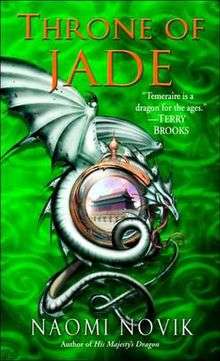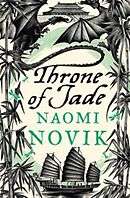Throne of Jade
Throne of Jade is the second novel in the Temeraire alternate history/fantasy series written by American author Naomi Novik. It was published by Del Rey first in the United States on April 25, 2006 and was published in the United Kingdom in August 2007 by Voyager.
 First paperback edition cover | |
| Author | Naomi Novik |
|---|---|
| Cover artist | Dominic Harman |
| Country | United States |
| Language | English |
| Series | Temeraire |
| Genre | Alternate history / Fantasy |
| Publisher | Del Rey (US) Voyager (UK) |
Publication date | April 25, 2006 (US) August 2007 (UK) |
| Media type | Print (Paperback) |
| Pages | 398 pp [1] |
| ISBN | 0-345-48129-1 |
| Preceded by | His Majesty's Dragon |
| Followed by | Black Powder War |
Plot introduction
The story is set during an alternate history version of the Napoleonic Wars, in which dragons not only exist but are used as a staple of aerial warfare in Asia and Europe. The dragons are portrayed as sapient and intelligent, capable of logical thought and human speech. The series centers on events involving Temeraire (the titular dragon) and his handler, William Laurence. The first book of the series centered on how Laurence, formerly a Captain in the Royal Navy, becomes Temeraire's handler, and their early training in preparation for battles against Napoleon's aerial fleet.
Synopsis

After defeating Napoleon's forces at the battle of Dover, Laurence and Temeraire are confronted by envoys from Imperial China, including Prince Yongxing, brother of the Jiaqing Emperor. The Chinese are eager to recover their rare Celestial dragon from the British. According to Chinese law, Celestials are only allowed to accompany royalty; Temeraire was intended for Napoleon, Emperor of the French, while Laurence, a mere commoner, is deemed unworthy.
After several failed attempts to convince Laurence and the Royal Aerial Corps to return Temeraire to China, the Chinese and the British agree to have Temeraire and his flight crew — including Laurence — accompany the Imperial envoys back to China. As the land routes are deemed unsafe, the Navy has a dragon transport, HMS Allegiance, captained by Laurence's former second officer Tom Riley, ferry the Celestial and his crew to China. During the voyage, attempts are made on the life of Laurence in order to remove him from Temeraire. In addition, political machinations on the part of the British, French, and Chinese are discovered that threaten the position of Britain in the East, as well as the stability of the Chinese throne. Finally, Laurence has ongoing difficulties with both Captain Riley, a staunch supporter of the slave trade (Laurence himself descends from known abolitionists), and the diplomat Arthur Hammond, sent along to smooth the operation.
During the sea voyage, Temeraire catches a respiratory illness from Volatilus, a slow-minded though sweet-natured Greyling serving in the courier corps who visits the Allegiance with dispatches. By use of a posset made using an extremely smelly mushroom, the cooks of the Chinese delegation are able to restore Temeraire to health. This event, though seemingly unimportant at the moment, shapes the next two novels of the series.
After their arrival in China, Temeraire gets to meet his family, including his mother, and observes the conditions of dragonkind in China, which he deems far superior to British custom: Chinese dragons are citizens in their own right who, amongst other things, may take the Confucian civil service exam. He begins courting an Imperial dragon named Mei, and is exposed to a young boy of Yongxing's company, who attempts to befriend him. Laurence, for his part, attempts to learn Chinese, liaises with the French ambassador de Guignes, and suffers more direct attempts on his life, including confrontations with Yongxing and his companion, the albino Celestial Lien. Hammond is able to deduce that Yongxing has designs on Prince Mianning, the heir-apparent whose dragon is Temeraire's twin brother, and that Temeraire was sent to France not because the Chinese esteem Napoleon but so that Temeraire himself could not be used to complicate the line of succession. Thus, his presence is necessary to lend legitimacy to any puppet king Yongxing intends to set upon the throne.
At a theatre production in the British delegation's honor, Yongxing attempts to put his plans in motion, but is prevented by the actions of Temeraire and Laurence, and is himself killed in the ensuing scuffle. As a result, the Emperor of China himself adopts Laurence as an honorary son, at a stroke resolving the issues with Laurence's social status and easing relations with Britain. Temeraire, after much deliberation, decides to return to Britain, partially out of love for Laurence and partially to attempt to bring the greater civil liberties of the Middle Kingdom back to the Commonwealth.
Notes
Novik includes an allusion to the legend of Hua Mulan, or at least the Disney version:
[Laurence's] dismay was evident, and Zhao Wei, perhaps feeling a need to defend his nation's unusual practice, proceeded to narrate the legend which was its foundation. The details were of course romanticized: a girl had supposedly disguised herself as a man to fight in her father's stead, had become the companion to a military dragon and saved the empire by winning a great battle; as a consequence, the Emperor of the time had pronounced girls acceptable for service with dragons.
Historical context
The historical Chinese policy of isolationism is a major plot point. The smuggling of opium and other European activities in China influence Chinese attitudes, but the presence of dragons results in a greater capacity to fend off European powers and maintain control over the borders.
In the alternate setting, dragons are an important part of Chinese society. Unlike the European nations, which consider dragons to be barely controlled monsters, the Chinese folklore on dragons views them as symbols of power, wisdom, and good luck. Dragons are considered equal citizens and it is even mentioned in the text that dragons have sometimes held the throne. The book reveals that the status of Celestial dragons in China resulted in the events of the first book; rather than simply invoking dragons as symbols, emperors in the Temeraire setting have actual dragons (specifically the Celestial breed) as bond companions. In order to prevent a crisis of succession from two Celestials, the court decided to send Temeraire's egg to Napoleon because he held the title Emperor, perhaps unaware that it was self-styled.
Historical persons
The Daoguang Emperor is portrayed before his accession to the throne. Although he is considered by some historians to have been an ineffectual ruler,[2] the British characters respect him, albeit due to their own interests. He does not favor an isolationist policy. Laurence and Temeraire's actions result in a strong diplomatic link between China and England that did not exist in history.
Prince Cheng, referred to by his name Yongxing, is the book's primary antagonist. He is a strong supporter of isolationism and attempts to usurp Mianning by placing Mianning's younger brother Miankai on the throne. He makes several attempts to kill Laurence, culminating in a mercenary attack on a guest house where the British characters are quartered; when the plot is revealed, Temeraire kills Yongxing in revenge. The book takes place in 1806; historically, Yongxing served in Mianning's military council and died in 1823. His character in the book is cold and aloof to the British, only occasionally letting slip emotion or opinions; however, he is shown to have genuine affection for the dragon Lien and made her his companion in spite of her albinism causing her to be viewed as cursed and unlucky.
De Guignes, as a Frenchman, is naturally an antagonist for Laurence and Temeraire. Although he does not secure an alliance with China, he gains Napoleon a significant asset by persuading Lien, a dragon, to join the French and revenge herself on Laurence and Temeraire. This action results in significant alterations to the historical timeline in future books, as Lien is shown to be an intellectual equal to Napoleon.
Reception
Throne of Jade was released to positive reviews; SF Reviews described it as having "sumptuous locales, thrilling action, and thematic and emotional heft,"[3] while Bookmarks Magazine called it "a solid second entry in what is shaping up to be an intriguing series."[4] Strange Horizons stated in their review that readers of the series "will find plenty to enthrall and captivate them."[5]
References
- "Throne of Jade on Barnesandnoble.com". Barnes & Noble. Retrieved 2008-05-01.
- Spence 1999, p. 149, 166.
- Thomas M. Wagner (2006) Throne of Jade Review, SF Reviews.net, accessed May 3, 2013
- August 22, 2007 Throne of Jadeby Naomi Novik, Bookmarks Magazine, accessed May 3, 2013
- Rose Fox, (August 14, 2006) Throne of Jade and Black Powder War by Naomi Novik Archived 2011-11-27 at the Wayback Machine, accessed May 3, 2013
- Maclay, Robert Samuel (1861). Life Among the Chinese: With Characteristic Sketches and Incidents of Missionary Operations and Prospects in China. NewYork: Carlton & Porter.